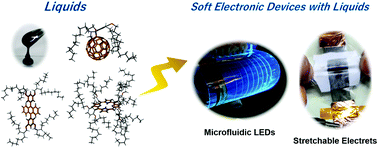Alkyl-π functional molecular liquids towards soft electronics
Abstract
A new trend in electronics is “soft electronics” possessing freely deformable, stretchable, and bendable features on flexible devices. Soft electronic devices have attracted attention in the fields of energy harvesting, healthcare equipment, fashion, architecture, and art. Conventional approaches regarding active materials fabricated into soft electronic devices include the utilisation of organic or polymer semiconducting materials. However, there is also tremendous demand for “extremely soft materials” that can undergo free deformation to fit various shapes of substrate without structural collapse in response to mechanical forces. A promising material for meeting this demand is functional molecular liquids (FMLs), in which optoelectronic functions are determined by the π-conjugated moiety and the liquid nature allows direct painting, nipping, and soaking. Over the past decade, our group and others have developed nonvolatile, room-temperature FMLs by introducing flexible yet bulky alkyl chains into various π-conjugated molecules. The shielding effect generated by the alkyl side chains produces highly stabilised optical and electronic properties for the corresponding π-cores. In this Highlight, we describe the recent achievements of the alkyl-π FMLs towards soft electronics with light-emitting, photovoltaic, and electret functions.

- This article is part of the themed collections: Journal of Materials Chemistry C Lunar New Year collection 2022 and Materials for molecular electronics and magnetism


 Please wait while we load your content...
Please wait while we load your content...